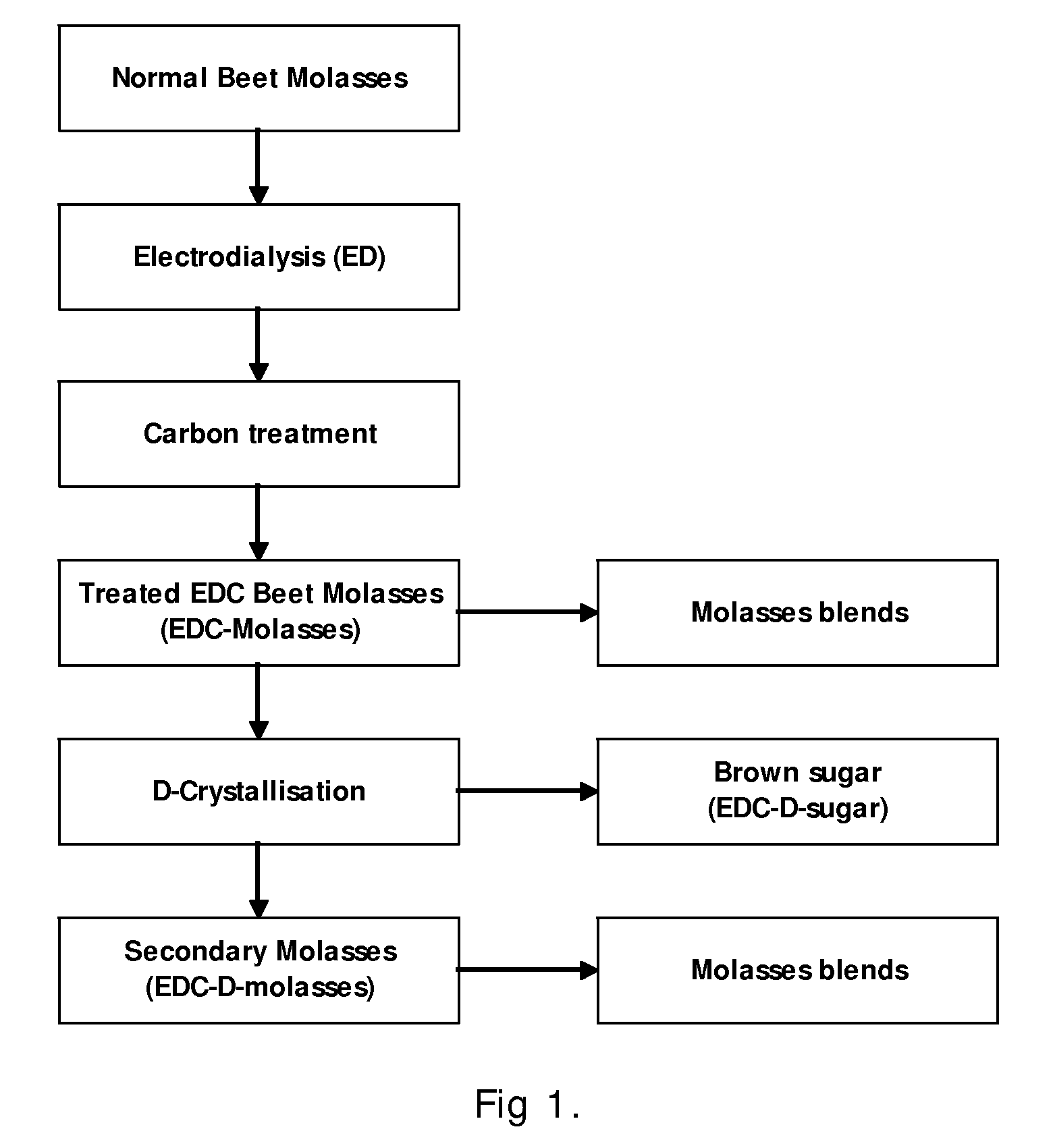Process For The Recovery Of A Brown Food-Grade Sugar Product From A Sugar Beet Solution
a technology of brown food-grade sugar and sugar beet, which is applied in the field of sugar manufacturing industry and flavouring industry, can solve the problems of affecting the crystallisation of sucrose, altering the chemical composition of raw juice, and affecting the purity of raw juice, and achieving the effect of increasing the purity of molasses
- Summary
- Abstract
- Description
- Claims
- Application Information
AI Technical Summary
Benefits of technology
Problems solved by technology
Method used
Image
Examples
example 1
[0063]Example 1 comprises the following steps:[0064]1) Electrodialysis (ED) of normal sugar beet factory molasses producing a purified ED-molasses with reduced odour and off-taste;[0065]2) Carbon treatment of purified ED-molasses producing treated EDC-molasses essentially free of off-odours and off-tastes, suitable for making molasses blends;[0066]3) Evaporative crystallisation of the purified and carbon treated EDC-molasses producing an EDC-massecuite;[0067]4) Centrifugation of the EDC-massecuite producing a brown sugar and an EDC-D-molasses exhausted of sugar and similar in purity to normal factory molasses.
[0068]The composition of the beet molasses fed to the ED unit was analysed as follows:
Pol, %49.1Refractive Dry Substance (RDS), %79.0Pol purity, %62.2Invert sugar, % on RDS0.7Conductivity ash, %11.5pH6.7Colour, I CUMSA74,000Pol = The apparent sucrose content expressed as a percentage by mass and determined by polarisation method.Pol Purity = The percentage ratio of pol to the t...
example 2
[0091]Example 2 comprises the following steps as shown in FIG. 2:[0092]1) Electrodialysis (ED) of normal untreated sugar beet factory molasses to produce a purified ED-molasses;[0093]2) Evaporative crystallisation of the purified ED-molasses on factory-scale using a 30 m3 batch vacuum pan to produce an ED-D-massecuite;[0094]3) Cooling crystallisation of the ED-D-massecuite from 80° C. to 50° C. over 48 hours by natural cooling in a stirred strike receiver;[0095]4) Centrifugation of the ED-D-massecuite by a continuous centrifuge producing a brown sugar and an ED-D-molasses exhausted of sugar and of similar purity to normal untreated factory molasses;[0096]5) Refining of the brown sugar to white sugar in the traditional way by re-dissolving and re-crystallisation;[0097]6) Carbon treatment of the ED-D-molasses to produce and ED-D-C-molasses.
[0098]The process steps are illustrated in the block diagram in FIG. 2.
[0099]Electrodialysis:
[0100]The feed molasses was diluted from 77.8% refract...
example 3
[0112]Example 3 comprised blending the carbon treated EDC-D-molasses, produced as explained in example 1, to food-grade cane molasses.
[0113]ED and carbon treated beet molasses lacks some of the significant liquorice and salmiac taste of cane molasses needed to spice up liquorice-type dark candies. To make a product suitable for making liquorice, the ED and carbon treated beet molasses was blended to food-grade cane molasses at levels of up to 30%.
[0114]Sensory tests of the blends were made by a panel of 28 participants. The judgement was EDC-molasses could be blended in the amount of 20-30% with food-grade cane without losing the desired liquorice and salmiac tastes necessary for making liquorice.
PUM
| Property | Measurement | Unit |
|---|---|---|
| pH | aaaaa | aaaaa |
| pH | aaaaa | aaaaa |
| pH | aaaaa | aaaaa |
Abstract
Description
Claims
Application Information
 Login to View More
Login to View More - R&D
- Intellectual Property
- Life Sciences
- Materials
- Tech Scout
- Unparalleled Data Quality
- Higher Quality Content
- 60% Fewer Hallucinations
Browse by: Latest US Patents, China's latest patents, Technical Efficacy Thesaurus, Application Domain, Technology Topic, Popular Technical Reports.
© 2025 PatSnap. All rights reserved.Legal|Privacy policy|Modern Slavery Act Transparency Statement|Sitemap|About US| Contact US: help@patsnap.com


